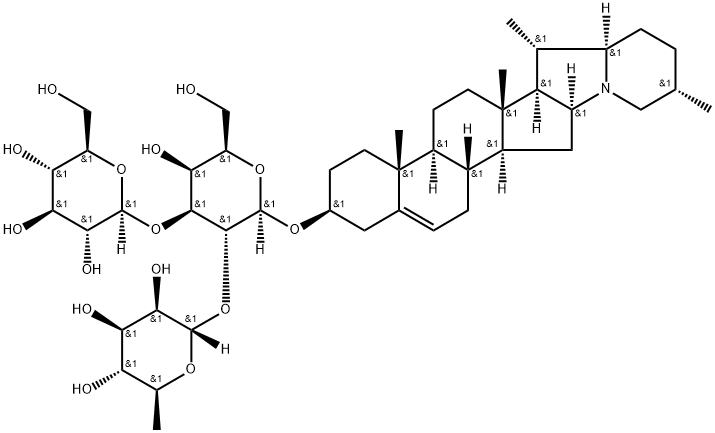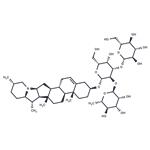This steroidal alkaloid is present in several Solanum species including S. nigrum,
S. Iycopersicum (tomato) and S. tuberosum (potato). The base crystallizes in
slender needles and shrinks markedly at 235°C. It has [α]20D - 59.45° (pyridine)
or - 42.16° (dilute HCl) and is readily soluble in hot EtOH, sparingly so in H20
and virtually insoluble in CHCl 3 or Et2 0. The salts are mostly amorphous
although a crystalline hydrochloride has been prepared with m.p. 212°C (dec.).
It is not affected by alkalies but mineral acids hydrolyze it to solanidine (q.v.)
and one mole each of dextrose, galactose and rhamnose.
Pharmacologically, the alkaloid is a protoplasmic poison and a powerful
haemolytic. Poisoning by potatoes sometimes occurs although the results are not
usually fatal. The symptoms are nausea, headache, emesis and gastritis. With
large doses parenchymatous nephritis and haemoglobinuria occurs with, at times,
paralysis of the central nervous system and cardiac arrest. The alkaloid also
possesses local irritant properties.
α-Solanine is produced as a by product in the synthesis of α-Chaconine. α-Chaconine is a glycoalkaloid displaying nerve toxin activity. Potential antifungal activity.
ChEBI: A glycoalkaloid poison found in species of the nightshade family (Solanaceae), such as the potato (Solanum tuberosum). It is a trisccharide derivative of solanidine [(22beta)-solanid-5-en-3beta-ol].
It has been revealed that α-solanine possesses potential chemotherapeutic action against cancers in several organs, including lung, breast, esophagus, prostate, and liver, as well as acute lymphocytic leukemia. α-solanine also has potential anti-inflammatory properties[1].
This substance is a primary reference substance with assigned absolute purity (considering chromatographic purity, water, residual solvents, inorganic impurities). The exact value can be found on the certificate. Produced by PhytoLab GmbH & Co. KG
In vitro studies have shown that alpha-Solanine's anti-cancer mechanism of action is induction of apoptosis, inhibition of cell proliferation and angiogenesis[1]. It also regulates the nuclear factor-κB (NF-κB) signalling pathway in tumour cells and macrophages[2].
A small amount of α-solanine can cause common symptoms such as dizziness, nausea, abdominal pain, vomiting, and diarrhea. Excessive consumption of α-solanine can lead to convulsions, coma, and even death. Animal studies have shown that α-solanine can damage the reproductive system[1].
alpha-Solanine is the major glycoalkaloid in the potato plant and is toxic. Potatoes generally contain toxic alpha-Solanine when they have been left for a long period of time resulting in a greenish colouration of the surface. Poisoning after ingestion is manifested by nausea, vomiting, diarrhoea, abdominal pain, fever or below normal body temperature (hypothermia), slow pulse and/or respiration, and confusion.
Recrystallise -solanine from EtOH, 85% aqueous EtOH, MeOH or aqueous MeOH as dihydrate m 276-278o. It solubility in H2O is 25mg/L and 5% in pyridine, but it is very soluble in Et2O and CHCl3. The hydrochloride is gummy or amorphous but has been crystallised (m ~212o dec). It has insecticidal properties. [Kuhn et al. Chem Ber 88 1492 1955, Beilstein 21 III/IV 1402.]
Desfosses.,lahresb., 2, 114 (1820)
Firbas., Monatsh., 10, 541 (1889)
Cazeneuve, Breteau., Compt. rend., 128,887 (1899)
Davis., Pharm. I., 15, 160 (1902)
Wittman., Monatsh., 26,445 (1905)
Colombano., Gazzetta, 38, 19 (1908)
Zemplen, Gerecs., Ber., 61,2294 (1928)
Schopf, Herrmann., ibid, 66, 298 (1933)
Oddo, Caronna., ibid, 67,446 (1934)
[1] Zhilong Chen. “α-Solanine Causes Cellular Dysfunction of Human Trophoblast Cells via Apoptosis and Autophagy.” Toxins (2021).
[1] MARYAM MOHSENIKIA . The protective and therapeutic effects of alpha-solanine on mice breast cancer[J]. European journal of pharmacology, 2013. DOI:10.1016/j.ejphar.2013.09.015.
[2] NAN WANG. Alpha-solanine inhibits endothelial inflammation via nuclear factor kappa B signaling pathway.[J]. Advances in Clinical and Experimental Medicine, 2023. DOI:10.17219/acem/158781.

